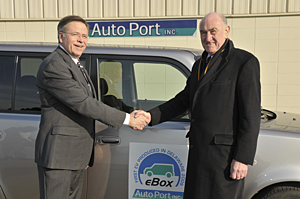Millions lost power from Maine to New York to West Virginia as a rare October snowstorm felled trees on power lines and the electric grid failed. If electric utilities had a smarter grid with more advanced distribution technology, only thousands might have lost power not millions. Businesses and homes with vehicle-to-home (V2H) technology could have used emergency backup power from electric cars.
I recently attended the Networked EV Conference where Greentech Media assembled expert presenters about smart grid, power generation and transmission, and electric cars. Today, there is a concern that too many electric cars charging at the same time could damage transformers and cause power outages. In a few years, electric cars and the re-purposed use of their lithium batteries will make our future more energy secure.
Unlikely as it seems, Northeastern utilities may learn how to better handle snowstorm power outages from the Southwest. In the Northeast, the grid is designed to flow electricity in one direction, from large coal and nuclear plants to businesses and homes. In the Southwest, they are upgrading their electric grid to handle the electricity generation from solar power and other forms of distributed generation.
About 20 percent of San Diego County’s electricity comes from renewable energy. Solar panels cover everything from small homes to 7 MW of solar covering school district buildings. San Diego accommodates this distributed generation with a series of smart grid implementations including smart meters, solid-state transformers, smart distribution assets that help identify and isolate local faults before they take down communities or the entire system. Smart grid assets communicate and receive instructions over various wireless and wired networks. A geographical information system tracks all key assets and information. SDG&E Smart Grid Report.
Vehicle-to-Home and Vehicle-to-Grid
More advanced than San Diego’s initiatives are Japan’s. After the devastating earthquake and tsunami, thousands provided emergency power to their homes from their hybrid and electric cars. Most often, the homes had solar power and used the system’s inverter to convert electricity from the car batteries. In Japan, lives were saved from vehicle-to-home (V2H).

Over 20 U.S. utilities have tested V2H and the more advanced vehicle-to-grid (V2G) where the Eastern U.S. has taken the lead as the giant electricity wholesaler PJM plans the deployment of 100 V2G cars after years of simulating their impact with large-scale lithium energy storage. University of Delaware Report.
V2G and V2H will see gradual U.S. deployment in this decade. Electric car makers typically offer an 8-year / 100,000 mile warranty on their advanced lithium battery packs. Use your personal electric car for V2G or V2H and you void the warranty. However, U.S. commercial and government fleets have over 10 million vehicles. In these fleets, we will see successful tests of V2H and V2G, first by the hundreds, then by the thousands of vehicles.
Better Place with over $300 million invested provides a range of services including leasing lithium batteries to fleets and countries. In Better Place battery switch stations and hundreds of idle batteries, which will be used for V2G. Both V2H and V2G have the potential to stabilize the grid by providing power when most need, for regulatory services, during peak demands in hot summers, and during emergencies.
Short-term, V2H and V2G, is a pain for automakers and utilities that must implement new IT systems. In the longer-term it is a way for both to expand their businesses, add value, and make more money.
Smart Pricing, Stable Grids and Sustainable Energy
As the grid gets smarter and as utility regulators in our 50 states allow more dynamic pricing, the grid will be more stable and electricity customers will have more tools to control their monthly bills. My friend Walt runs an energy-intensive plastic injection molding company. His battle with Asian competitors is tougher than ever. One way that Walt saves thousands monthly to stay competitive is to run the most energy intensive operations when electricity is cheap. Commercial customers get time of use (TOU) pricing that makes electrons cheap off-peak and pricy during the hottest hours of the day when air conditioning runs.

Today, commercial customers take advantage of dynamic pricing to curtail services when prices are high and to provide generated and stored electricity to the grid when it makes money. Demand response (DR) is becoming a popular way to improve the bottom line by reducing HVAC demands, dim lighting, and shift the hours of some devices. In a new report, Pike Research states, “DR services sector still represents an evolving market, it is currently relatively small with an estimated worldwide spending of $1.3 billion in 2011. Thanks to a variety of positive market forces, especially the widespread installations of smart meters, this market is projected to experience a robust compound annual growth (CAGR) rate of 37% to become a multi-billion market by 2016. Of the three key segments, curtailment services are the largest with an expected global market of $748 million in 2011. The systems integration/consulting services and outsourcing markets also offer promising opportunities for demand response vendors with CAGRs of 32% and 31% respectively, on a worldwide basis.”
Selling distributed power, distributed stored energy, and DR is automatically managed in large enterprises with Energy Management Systems (EMS) that are thoughtfully described in Carol Brzozowsk’s article in Distributed Energy. Eventually these sophisticated systems of software, sensors, and controls will extend to the home with smart EV charging, smart appliances, and cloud IT services that allow homeowners to establish and meet their preferences.
Automating Energy Savings at Home
In the future, homes will have dynamic pricing. We will use a service, typically accessed through our internet browser, and set-up our preferences for doing things when electricity is cheap. Our preferences could include charging electric cars, making ice in the refrigerator, washing and drying clothes, and moderating HVAC. Our utility does not control what we do. It simply sends price signals over a smart grid and smarter cars and appliances implement our preferences. We can of course, override. For example, 95 percent of the time, I charge my Nissan LEAF off-peak, but occasionally override for immediate charging.
Honeywell with thermostats in 150 million homes and Opower will jointly develop energy management tools to help consumers cut their energy use and expenses. The companies will combine Honeywell’s expertise in residential automation and control systems with Opower’s industry-leading energy data analytics and customer engagement techniques to create technology that will provide energy savings in the home and across the entire electrical grid.
Honeywell and Opower will initially launch a platform that includes an internet connected programmable thermostat that can respond to price signals to help homeowners save money and utilities boost energy efficiency programs. The technology will measure, analyze and report homeowners’ electricity use, including detailed information from the thermostat, which controls heating and cooling systems — equipment that accounts for almost 50 percent of all residential energy consumption.
Utility customers will be able to access the data from a Web portal or mobile application to get a clear and comprehensive snapshot of their energy use and spending. The technology will also suggest and automatically implement cost-saving changes, and will present equivalent data from similar families in the same geography to provide a benchmark and additional context. The industry is rich with technology innovators and service providers to help us manage energy with intelligence, efficiency, and reliability.
Lithium Batteries – Reduce, Reuse, Recycle
What will happen faster than V2H and V2G is the redeployment of lithium batteries from electric cars to buildings and homes. Automakers have seen the cost of lithium battery pack from $1,000/kW to $500/kW and may reach $250/kW by the end of the decade. We may even see breakthroughs in new battery chemistry. Five years from now automakers might offer to trade-out old packs for new ones with 50 to 100% more range.
Solar installers, electrical contractors, and energy service companies could installed the old packs in commercial buildings and homes to buy electricity from utilities when prices are cheap and use the stored electricity when utility rates are high. Such energy storage could now keep the lights on in cities shut down by power outages.
 I was talking with Pete Rive, a Founder and COO of Solar City, a system integrator that has expanded from commercial and residential solar to also install solar electric car charging. Rabobank has 12 locations with 225kW of solar power and electric car chargers installed by Solar City. The network of brings EV drivers closer to the dream of driving from Northern to Southern California, charging along the way. In fact, Pete Rive can make the drive now since he owns a Tesla Roadster. Pete Rive would be willing to pay $200/kWh for repurposed lithium car batteries to be used in wall-mounted storage projects in homes and businesses.
I was talking with Pete Rive, a Founder and COO of Solar City, a system integrator that has expanded from commercial and residential solar to also install solar electric car charging. Rabobank has 12 locations with 225kW of solar power and electric car chargers installed by Solar City. The network of brings EV drivers closer to the dream of driving from Northern to Southern California, charging along the way. In fact, Pete Rive can make the drive now since he owns a Tesla Roadster. Pete Rive would be willing to pay $200/kWh for repurposed lithium car batteries to be used in wall-mounted storage projects in homes and businesses.
In the future, we will have the tools to reduce massive power outages and use energy stored in homes and buildings for emergency backup power. With distributed generation and energy storage, the 24×7 demand for electricity will be more balanced. Dynamic pricing signals to smarter homes and buildings will be used by systems that match our preferences for heating, cooling, lighting, and charging electric cars.
Electric Vehicles 2011: Technology, Economics, and Market – GTM Research Report


Hello Sir,
We are going to develope the project for the V2H system in India.
So can you please help me the Technical Specifications that required to develope the V2H system? Like Inverter, PV Array specification, etc.
Kindly help us for that and it will be help us to get better output of our Project.
We are very confuce regarding the Technical Specifications for V2h System Development.
Kindly Help Us.
In case of any query, please feel free to contact me on my email id.
Regards,
Aniket Adhvaryu.
India.
Aniket,
It sounds like you have some exciting projects going. I’d suggest you contact the folks at UC Davis who have been studying this for more detailed help. Check out http://phev.ucdavis.edu/. Good luck.
-Ed